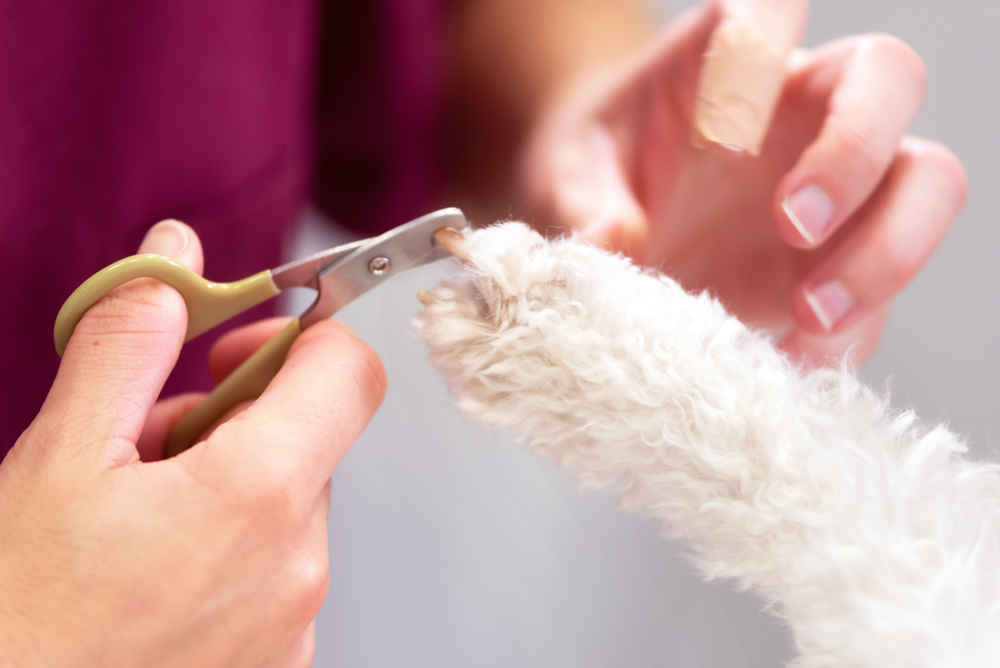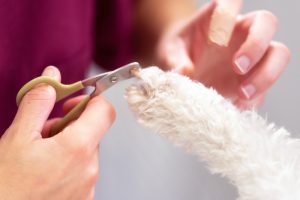As a Dog Owner, you might have grown fond of the clicky-clacky sound of your pupper walking over to ask for some cuddles. At the same time, you probably already know that by the time your dog’s nails are long enough to hit the ground, it’s likely time for a trim. Dog nail trimming certainly isn’t a favourite task for any Dog Owner (or vet tech, or Pet Sitter!) but it is necessary to keep your dog comfortable and healthy.
In this article, we’ll cover why your dog needs the occasional pedicure and how to cut dog nails with minimal discomfort—for you and your pooch.
Why dog nail trimming is important
As averse as many dogs are at the mere sight of the nail clippers, you might be wondering, why bother at all? Unfortunately, even though your dog would prefer for you to throw the nail clippers in the bin, the fact is, they need the occasional trimming. That’s because most modern day doggos aren’t as active as generations past, when regular activities on the farm or on the hunting field would keep their nails in good shape. If you’ve got a lovable housepet, chances are, they’re not wearing down their nails on their own.
The result can be overgrown nails that are prone to breakage and snagging on carpet and other surfaces. Not only are these injuries painful, but they might land you in an uncomfortable conversation with the vet when they tell you it all could have been avoided.
Perhaps even more concerning is the effect that too-long nails can have on your dog’s movement. Nails that get in the way of comfortable walking or playing may inhibit your dog’s desire to stay active. Or, the pain may encourage your dog to redistribute their weight in such a way as to minimise discomfort, thus stressing their muscles and joints.
Finally, long nails are something of a menace to everyone around your pup, from other furry friends at the dog park to your houseguests. We can bet that you don’t want your dog to earn the nickname Edward Scissorpaws—although that would make an incredible Halloween costume.
How to cut dog nails
Clearly, cutting your dog’s nails is important, but how is it done?
First of all, you’re going to need a pair of dog nail clippers designed for the size of your dog. You might opt instead for a nail grinder or other piece of equipment that may be more comfortable for your dog.
You’ll also need to know some basic anatomy of dog nails. Each nail has a quick in the centre, which houses the blood vessels and nerve endings. You need to be able to identify the quick so that you can avoid it! In dogs with light, semi-transparent nails, you can see the quick from the side or by holding the nail in front of a light source. For puppers with dark nails, you may not be able to see the quick and should be extra careful when cutting the nail.
When you’re ready to trim the nail, follow these steps:
- Hold your dog’s foot firmly but not forcefully
- With your thumb on the paw pad and your forefinger on the top of the digit, press gently so that the nail is pushed forward and exposed
- Line up the clippers with the natural curve of the nail, and then adjust the clippers down to a 45 degree angle (or more) away from the quick. This will ensure that you don’t accidentally cut the nail too short. It’s always better to cut a little bit at a time than cut too much and risk hitting the quick
- Clip the nail with one swift cut
- Repeat with all other nails and dewclaws
How to cut dog nails without them hating it
Okay, so now you have the basic steps to cut your dog’s nails. But how are you supposed to do that if your dog squirms and struggles every time you get the nail clippers close to them?
If that’s the case, it’s a good idea to work on some desensitisation and counter-conditioning before you do any nail trimming. Here are a few steps to you can take to prepare your pup for their pedicure:
- Set up a proper introduction with the grooming supplies. Often, Dog Owners will attempt to keep the nail clippers out of sight to wage a secret attack on those overgrown nails. Unfortunately, this can only make the anxiety worse. Instead, allow your dog to sniff and investigate the nail clippers, giving them plenty of tasty treats so that they can quell their fears and build a positive association with their grooming supplies
- Get your dog used to having their paws touched. It’s completely natural for a dog not to want their paws handled, so you’ll want to dedicate some time to counter-conditioning this instinct. Try touching their paws when they’re in a very relaxed state or, if there’s no history of resource guarding, when they’re eating or enjoying a treat. Ideally, this step is done from puppyhood, but you can teach your adult dog to tolerate having their toes held, too
- Take it slow. The key to getting your dog comfortable to nail clipping is to take the time to work through their fear and anxiety. And, if you think that sounds like a time-consuming endeavour, well, it certainly can be. If your pup’s nails are overgrown to a dangerous length, you might consider taking them to a professional dog groomer while working at home on counter-conditioning. Eventually, you’ll be able to cut the nails yourself without undue stress
- Only cut as many nails as your dog allows at a time. There’s no rule that says you have to cut all of your dog’s nails at once. So, if you’re only able to get a few trims in at a time, that’s okay! In fact, it’s a great way to minimise stress and stay under your dog’s tolerance threshold.
How often should you schedule dog nail trimming?
Once you’ve learned how to cut dog nails and started working through your dog’s discomfort, you might be wondering how often to trim your dog’s nails. As we hinted at earlier, this will all depend on your dog’s lifestyle and how quickly their nails grow.
For some dogs, a biweekly trim is necessary while others will only need a dog nail trimming session every few months. A good rule of thumb is to clip them when they’re long enough to make those cute clicky-clacky noises on hard surfaces.
Remember, finally, that the dew claws need extra care, as they typically don’t wear down as readily as other nails even if your dog does have regular outings with you or a dedicated Dog Walker. They’ll need more frequent trimming.
Final thoughts for cutting dog nails
To be sure, trimming your pup’s nails is not the most fun activity you’re going to do with your dog. But, in most cases, your pupper will need some help with keeping their nails in tip-top shape.
Remember to take it slow, make small snips, and end each dog nail trimming session with plenty of treats and cuddles!


